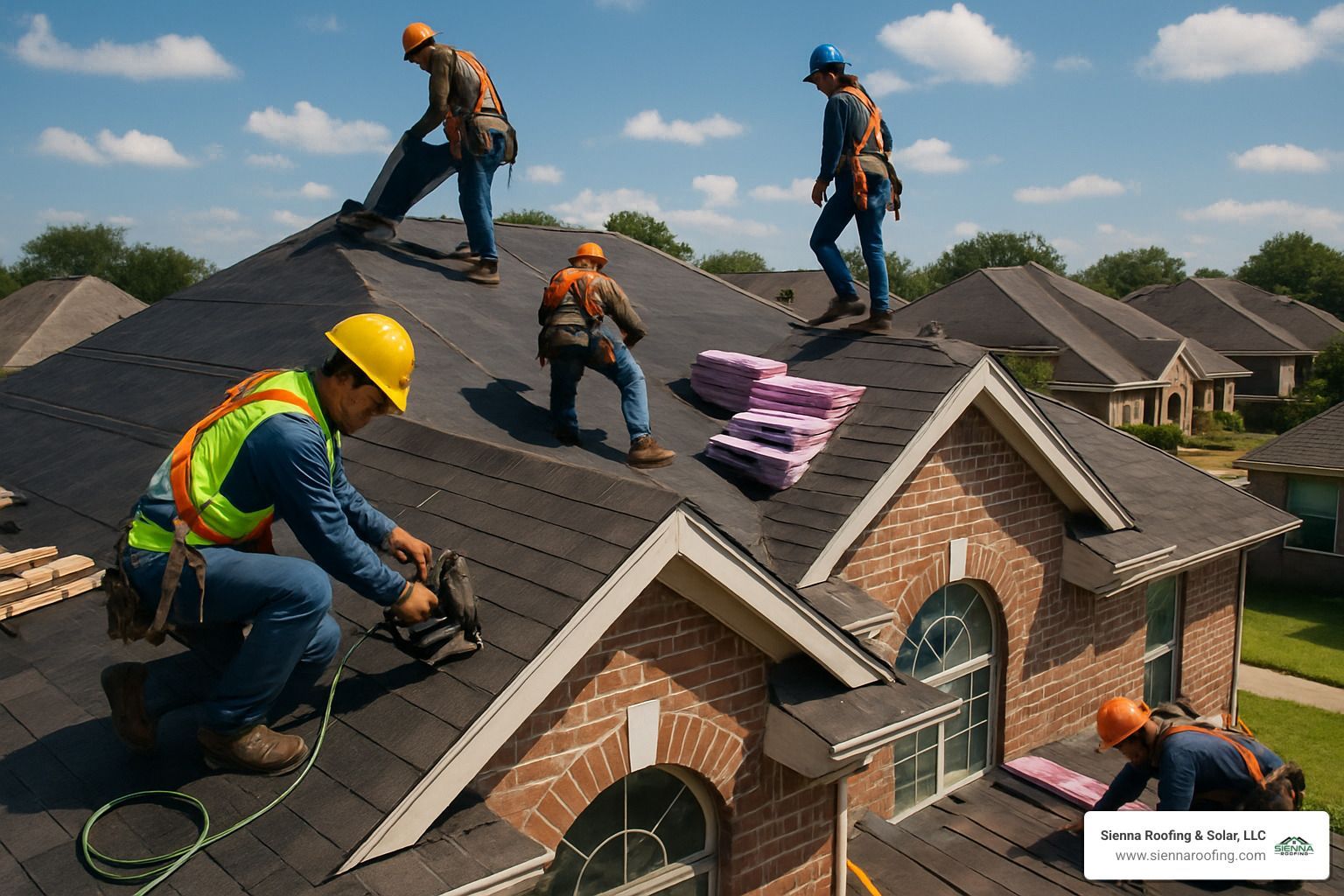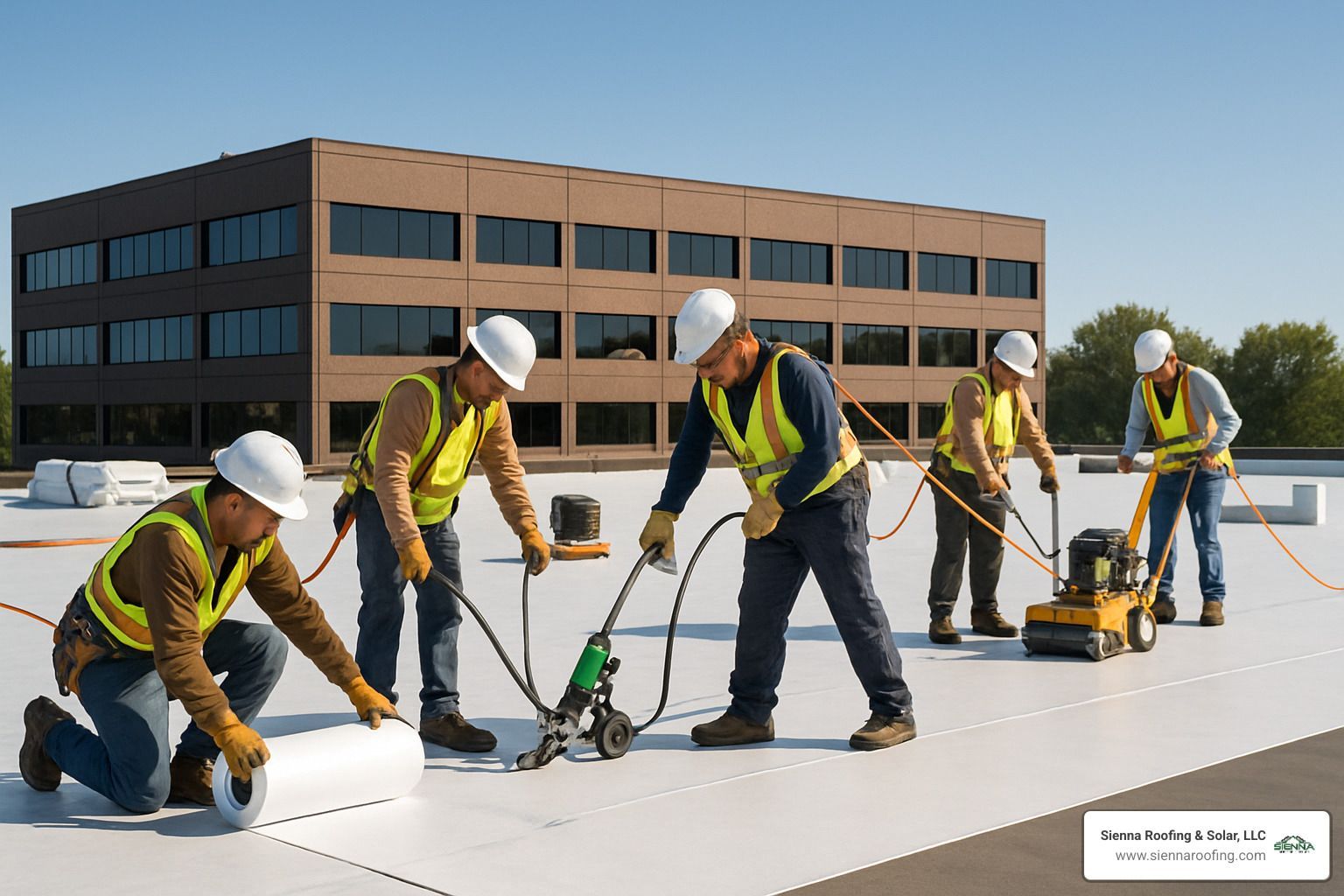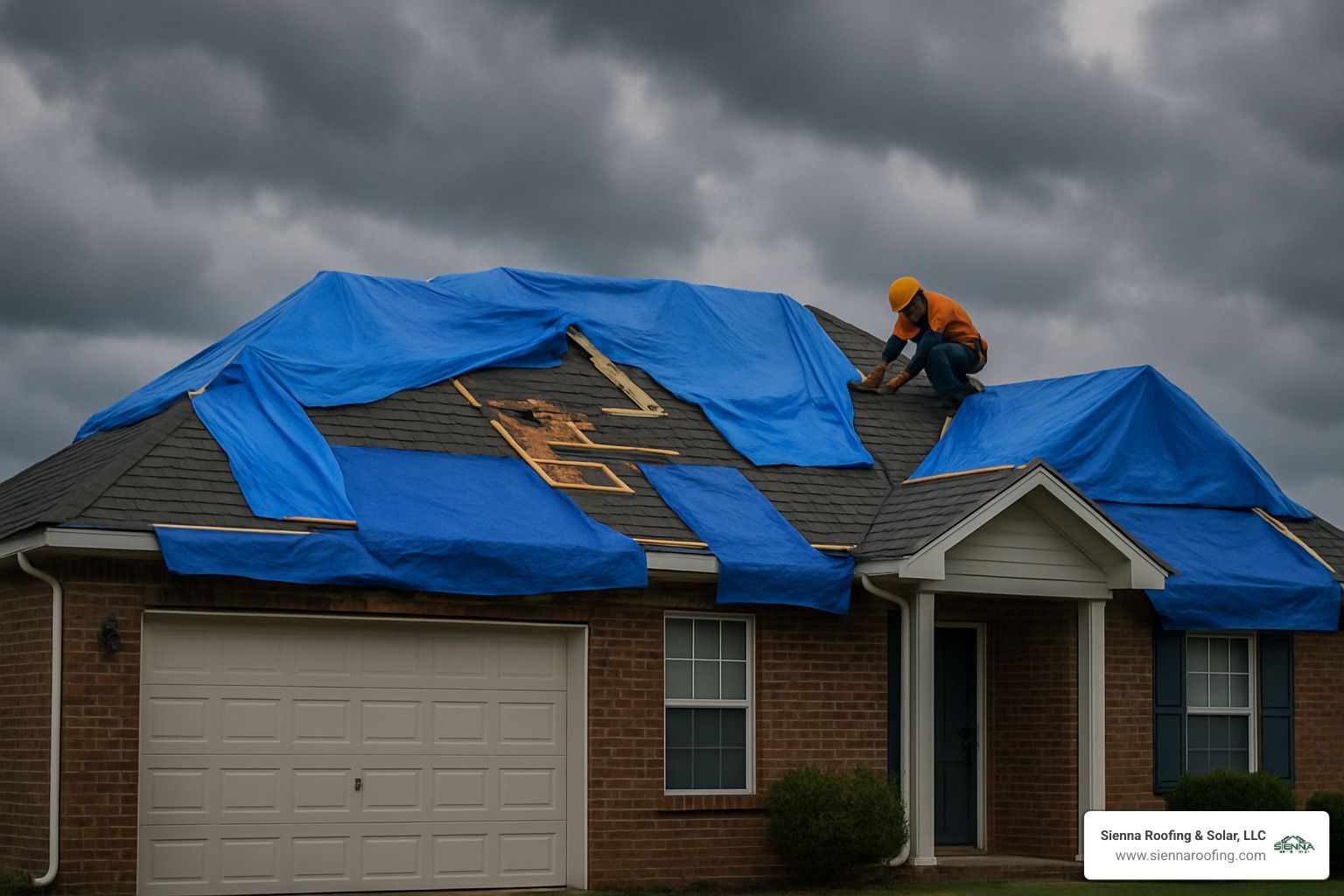Raise Your Roofing Game – Metal Roof Installation Simplified

Andre Castro
Owner of Sienna Roofing
Why Metal Roof Installation Is the Smart Choice for Texas Homeowners

Metal roof installation is becoming the go-to solution for homeowners who want durability, energy savings, and long-term value. Here's what you need to know:
Key Steps for Metal Roof Installation:
- Measure and plan- Calculate roof area plus 10% waste allowance
- Prepare the surface- Install underlayment and drip edge
- Install panels- Start from eave to ridge with proper overlap
- Secure fasteners- Use neoprene washer screws every 12-16 inches
- Add finishing touches- Install ridge caps and flashing
- Final inspection- Check for gaps and proper sealing
Metal roofs last 50-70 years compared to asphalt's 15-20 years. They can reduce energy bills by up to 30% and cost between $8.75-$25 per square foot.
DIY vs Professional: While skilled DIYers can handle simple structures like sheds, complex roofs with multiple angles, dormers, or multi-story homes are best left to professionals for safety and warranty protection.
As Andre Castro, CEO of Sienna Roofing & Solar, I've overseen hundreds of metal roof installation projects across the Houston Metro area over the past five years.

What You'll Learn
In this comprehensive guide, we'll walk you through everything you need to know about metal roof installation. We'll cover the complete scope of the project, from initial planning to final inspection. You'll learn when DIY makes sense and when it's time to call the professionals.
Most importantly, we'll emphasize safety first throughout every step. Whether you're tackling a simple shed roof or planning a complex residential installation, understanding proper safety protocols is non-negotiable.
Why Choose Metal Roofing Over Asphalt
When we meet with homeowners in Sugar Land, Katy, and across the Houston Metro area, most have never seriously considered metal roof installation. But once we show them the numbers, they quickly understand why metal roofing is taking off.
The longevity difference alone is eye-opening. Your typical asphalt shingle roof lasts 15-20 years in our Texas climate. A properly installed metal roof? We're talking 40-70 years of protection.
Fire resistance becomes especially important during our dry Texas summers. Metal roofing earns the highest Class A fire rating, while asphalt shingles can actually feed flames during a fire. Many clients see their insurance premiums drop just by making the switch.
When hurricane season rolls around, wind resistance matters more than ever. Metal roofing can handle hurricane-force winds that would devastate traditional roofing materials.
The resale value boost is substantial too. Quality metal roofing increases your home's curb appeal and comes with transferable warranties that buyers love.
But here's where metal roofing really shines in Texas: energy savings. Those dark asphalt shingles absorb heat all day, turning your attic into an oven. Metal roofs with reflective coatings bounce that Texas sun right back. We regularly see 30% reductions in cooling costs.
| Feature | Metal Roofing | Asphalt Shingles |
|---|---|---|
| Lifespan | 40-70 years | 15-20 years |
| Energy Savings | Up to 30% reduction | Minimal |
| Fire Rating | Class A | Class A to C |
| Wind Resistance | Hurricane-force | Moderate |
| Cost (per sq ft) | $8.75-$25 | $3-$7 |
Key Benefits at a Glance
50-Year Lifespan isn't just marketing talk. We regularly inspect metal roofs installed in the 1970s that are still going strong.
30% Energy Cut makes a huge difference in our climate. When your roof reflects heat instead of absorbing it, your air conditioner doesn't have to work nearly as hard.
Hail-Proof Performance gives you peace of mind during Texas storm season. While golf ball-sized hail can destroy asphalt shingles, quality metal roofing takes those hits and keeps protecting your home.
Popular Misconceptions
Noise Myth: Modern metal roof installation includes proper underlayment and insulation that actually makes metal roofs quieter than many asphalt installations.
Lightning Myth: Metal roofing doesn't increase your lightning risk. Actually, if lightning does strike, metal roofing is safer because it disperses the energy without catching fire.
Denting Concern: Most hailstorms that would destroy asphalt shingles barely leave a mark on quality metal roofing.
Materials, Styles & Costs for Metal Roof Installation
When I walk homeowners through their metal roof installation options, I always start with the basics: what's your metal roof actually made of?
Steel is our most popular choice. Whether you go with galvanized steel or Galvalume-coated steel, you're getting excellent durability that handles Texas weather. Steel roofing typically lasts 30-50 years and offers that sweet spot of performance and affordability.
Aluminum shines in coastal areas where salt air can be tough on other metals. It's lightweight and corrosion-resistant, making the extra cost worthwhile near the Gulf.
Copper is the premium choice that can last up to 200 years. The upfront cost is significant, but we're talking about a true lifetime investment. The way copper develops that beautiful patina over time is stunning.
Zinc offers similar longevity to copper (80-100 years) but with a more subdued look. Zinc is actually self-healing - minor scratches disappear over time as the zinc naturally repairs itself.
Now, let's talk styles:
Standing seam creates those sleek, modern lines with panels that interlock without exposed fasteners, giving you clean lines and superior weather protection.
Corrugated panels bring that classic metal roof charm. They're perfect for barn-style homes and are the most budget-friendly option.
Metal shingles let you have metal's durability with the look of traditional materials like slate, wood shake, or tile.
Metal roof installation typically runs $8.75-$25 per square foot, depending on your choices. Basic steel systems start at the lower end, while premium standing seam installations reach the higher range.
Gauge matters. Thicker panels (lower gauge numbers) cost more but give you better durability and noise reduction. We typically recommend 26-gauge steel for residential applications.
Paint systems deserve attention too. Basic polyester coatings are economical but fade faster. PVDF (Kynar) coatings cost more upfront but maintain their color for decades.
For detailed information on our options, visit our Metal Roofing page. You can also check out the latest research on standing-seam performance.
Choosing the Right Metal
Location matters when selecting your metal. Near the coast, aluminum's corrosion resistance justifies the extra investment. For inland areas, galvanized steel delivers excellent value.
Color matching can make or break your home's curb appeal. Modern metal roofing comes in dozens of colors. I always tell homeowners to order samples first - colors look different in morning versus afternoon sun.
Warranty tiers vary dramatically. Basic steel might come with 20-year warranties, while premium systems offer 50-year coverage. Read the fine print carefully - some warranties only cover material defects, not finish degradation.
Essential Tools, Safety Gear & Site Prep
Let's talk about the most important part of any metal roof installation- keeping yourself safe. Your safety harness isn't optional - it's your lifeline. Even experienced roofers can slip, and metal surfaces become surprisingly slick when wet.

The right tools make all the difference. Your chalk line helps you mark perfectly straight reference lines. Aviation tin snips cut through metal cleanly without jagged edges. An impact driver with a depth-locating nosepiece prevents over-driving screws, which is one of the most common mistakes we see.
You'll also need metal shears for heavier cuts, a hand seamer for bending trim pieces, and a circular saw with a metal-cutting blade for longer cuts.
Essential Personal Protective Equipment includes non-slip rubber-soled boots, safety glasses with side shields, cut-resistant gloves, a hard hat, and long sleeves. Metal edges are sharp enough to slice through skin before you realize what happened.
Synthetic underlayment outperforms traditional felt paper, especially in our Texas heat. Ice and water shield provides crucial protection for valleys and eaves. Drip edge flashing directs water away from your fascia boards and into the gutters.
Measuring & Ordering
Getting your measurements right is where many DIY projects go wrong. You can't just measure the footprint - roofs have slopes, and slopes mean more surface area.
A 10×10 foot section of roof with a 12/12 slope actually covers 141 square feet, not 100. Always order 10% extra material beyond your calculated needs for cuts, waste, and measuring mistakes.
Tear-Off vs Overlay
Overlay installation can save time and disposal costs if your existing shingles are in decent shape. But tear-off gives you x-ray vision- you can see exactly what condition your roof deck is in and spot any problems before they cause bigger issues.
Building codes in most Texas areas limit the number of roofing layers you can have, so check with your local building department before deciding.
Step-by-Step Metal Roof Installation
Metal roof installation is like putting together a giant puzzle that has to keep your family dry for the next 50 years. The secret to success lies in your layout plan.
Start by identifying the most visible side of your roof - that's where you want your panels to look absolutely perfect. Use the 3-4-5 method for square reference: measure 3 feet along one edge, 4 feet along the perpendicular edge, and if your diagonal measures exactly 5 feet, you're perfectly square.
Once you've snapped that chalk line from ridge to eave, install starter trim along the eave with about an inch overhang into your gutter. Make sure it's level because every panel follows its lead.
Panel fastening varies by system type. For corrugated panels, screws go through the high ribs into solid decking. Standing seam systems use clips that allow thermal movement.
Foam closures seal gaps between panel ribs and trim pieces. Skip them, and you'll have wind-driven rain and wasps in your attic.
Ridge venting deserves special attention in our Houston heat. Proper attic ventilation extends your roof's life and slashes energy bills.
Flashing around chimneys, vents, and penetrations separates pros from amateurs. Quality metal flashing provides decades of leak-free performance.
Use high-quality butyl tape or polyurethane sealants designed for metal roofing. Cheap sealants turn brittle and fail within a few years.
Maintain proper ventilation gaps and check panel alignment every few rows.
For additional technical guidance, this How-to panel guide provides helpful details.
Panel Laying & Fastening
Start installation on the side opposite your prevailing winds so panel overlaps face away from weather. Your screw pattern depends on panel type - corrugated panels typically need screws through every rib at eave and ridge, with intermediate screws no more than 24 inches apart.
Clip systems for standing seam require precision. Each clip must align perfectly with panel seams. Getting gasket torque right takes practice - too loose causes leaks, too tight damages the gasket.
Flashing & Finishing
Chimney flashing requires custom-formed step flashing integrated with each panel course. Pipe boots need EPDM rubber bases that conform to panel profiles.
Ridge cap installation completes your weather protection. Use outside closure strips to seal the ridge cap to your panel profiles. Apply sealant tape before installing the cap.
Touch-up paint prevents big problems later. Any scratches or cut edges need protection from corrosion. Use paint specifically designed for your panel material.
Maintenance, Warranty & Long-Term Value
Here's the beautiful thing about metal roof installation- once it's done right, you can practically forget about it for decades. The maintenance requirements are refreshingly minimal compared to traditional roofing materials.
Your annual inspection routine is straightforward. Walk around your home's perimeter and look for loose fasteners, degraded sealant around penetrations, and flashing areas where different roof planes meet. Most issues are minor when caught early.
Debris removal becomes second nature. After storms, clear off branches, leaves, or debris that might trap moisture. Keep gutters clean too - clogged gutters can cause water to back up under your roof edge.
Repaint cycles depend on your coating system. Basic polyester coatings might need touch-up after 15-20 years. Premium PVDF systems last 30+ years before any paint maintenance becomes necessary.
Those 50-year transferable warranties are a real selling point when you sell your home. Buyers love knowing they won't need to worry about roofing for decades.
Energy rebates are available in many areas for reflective metal roofing systems. The energy savings alone - often 20-30% reduction in cooling costs - frequently justify the investment within the first decade.
The solar readiness aspect is something more homeowners are considering. Metal roofs provide an excellent platform for solar panel installation without needing roof replacement like with asphalt shingles.
For commercial properties, explore our Commercial Metal Roof Replacement services.

Common Mistakes to Avoid
Over-tightened screws top the list of installation mistakes. When you crank down too hard, you deform the gasket and create leak points. Always use a drill with depth-locating attachment.
Mis-aligned panels create both visual and functional problems. Take extra time to get that first panel absolutely perfect, and check alignment every few rows.
Skipped sealant applications cause more metal roof leaks than any other factor. Sealant at critical joints isn't optional - it's your backup protection.
When to Call the Pros
Multi-story homes present safety challenges that require specialized equipment, extensive training, and proper insurance coverage.
Complex dormers and multiple roof intersections require advanced flashing skills that take years to develop. These areas are notorious for leaks when not detailed properly.
Insurance claims often require professional installation to maintain coverage. Check with your insurance company before starting any roofing project.
Frequently Asked Questions about Metal Roof Installation
Can I install a metal roof over existing shingles?
The short answer is yes - but there are important conditions. Your local building codes will be the ultimate deciding factor. Many areas limit how many roofing layers you can have.
The condition of your existing shingles matters tremendously. If they're relatively flat, well-adhered, and not showing significant wear, overlay can work. However, if you've got curling shingles or missing pieces, tear-off becomes the better option.
When we do overlay installations, we trim existing shingles flush with the fascia board and install proper underlayment over the old roof.
How much does a metal roof cost in Texas vs Ontario?
Pricing for metal roof installation is surprisingly similar between Texas and Ontario. In Ontario, profiled steel metal roofs typically run $8.75-$15 per square foot, while standing seam systems range from $15-$25 per square foot. Here in Texas, we see very similar pricing ranges.
Roof complexity is huge - a simple gable roof costs significantly less than a design with multiple dormers and valleys. Material choice matters tremendously. Steel panels offer the best value, while aluminum, copper, or zinc increase your investment considerably.
One advantage Texas homeowners have is the potential for greater energy savings. Our intense summer heat means metal roofing's reflective properties can generate more substantial cooling cost reductions.
What maintenance does a metal roof actually need?
The maintenance requirements are refreshingly minimal. Annual inspections should be your primary focus - check for loose fasteners, damaged flashing, or debris accumulation.
Debris removal is straightforward. Clean gutters regularly and remove leaves, branches, or debris from the roof surface.
Fastener maintenance involves checking exposed screws for looseness or gasket deterioration. Touch-up painting addresses scratches or areas where finish has worn through to bare metal.
Most of this maintenance is well within typical homeowner abilities. When you compare this to the regular repairs and replacements that asphalt shingles require, the difference is dramatic.
Conclusion
Metal roof installation is more than just a home improvement project - it's an investment in your family's comfort, safety, and financial future. When you consider that a quality metal roof can last 50-70 years while saving you thousands on energy bills, the decision becomes clear.
For homeowners with basic construction skills, simple roofs like sheds or single-story homes with straightforward designs can be DIY-friendly projects. However, complex roofs with multiple angles, dormers, or multi-story challenges are best handled by experienced professionals.
At Sienna Roofing & Solar, we've built our reputation on being your one-stop solution for all roofing and solar needs across the Houston Metro area. Our lifetime craftsmanship guarantee means we stand behind our work long after the last panel is installed.
We understand the unique challenges of roofing in Texas. From hailstorms that can destroy lesser materials to summer heat that tests every component, we've seen it all. That's why we only use the highest quality materials and proven installation techniques.
Our local expertise serves homeowners throughout Sugar Land, Missouri City, Katy, Richmond, Pearland, Rosenberg, Rosharon, Friendswood, Webster, Bellaire, and West University. We're not just contractors - we're neighbors who understand what it means to protect your most valuable asset.
The change that comes with metal roof installation goes beyond just protection. You'll notice the difference in your energy bills almost immediately. Your home's curb appeal will increase significantly. Most importantly, you'll have the confidence that comes with knowing your roof can handle whatever Mother Nature throws at it.
Ready to take the next step? Contact us today for a Free Roof Estimate and find why so many of your neighbors have chosen Sienna Roofing & Solar for their roofing needs.

Your roof does more than just keep rain out - it protects everything and everyone you care about most. When you choose metal roof installation, you're choosing materials and methods that provide the durability, efficiency, and peace of mind your family deserves.








